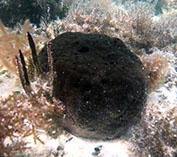Hippospongia lachne (de Laubenfels, 1936)
Sheepswool sponge| Native range | All suitable habitat | Point map | Year 2050 |

|
| This map was computer-generated and has not yet been reviewed. |
| Hippospongia lachne AquaMaps Data sources: GBIF OBIS |
Classification / Names Common names | Synonyms | CoL | ITIS | WoRMS
Demospongiae | Dictyoceratida | Spongiidae
Environment: milieu / climate zone / depth range / distribution range Ecology
Sessile; non-migratory; depth range 5 - 15 m (Ref. 108813). Tropical; 28°N - 8°N, 89°W - 113°E
Distribution Countries | FAO areas | Ecosystems | Occurrences | Introductions
Indo-West Pacific and Western Central Atlantic: from Belize north to Bahamas, south to Tamil Nadu India and east to China.
Length at first maturity / Size / Weight / Age
Maturity: Lm ? range ? - ? cm Max length : 28.7 cm OT male/unsexed; (Ref. 125998); max. reported age: 16 years (Ref. 125998)
Life cycle and mating behavior Maturity | Reproduction | Spawning | Eggs | Fecundity | Larvae
Main reference
References | Coordinator | Collaborators
Engel, S. and J.R. Pawlik 2005 Interactions among Florida sponges. I. Reef habitats. Mar. Ecol. Prog. Ser. 303:133-144. (Ref. 837)
IUCN Red List Status
(Ref. 130435: Version 2025-1)
CITES status (Ref. 108899)
CMS (Ref. 116361)
Threat to humans
Human uses
Fisheries: commercial; aquaculture: commercial
| FishSource |
Tools
More information
Diet composition
Food consumption
Predators
Max. ages / sizes
Length-weight rel.
Length-length rel.
Length-frequencies
Mass conversion
Abundance
Internet sources
BHL | BOLD Systems | CISTI | DiscoverLife | FAO(Publication : search) | Fishipedia | GenBank (genome, nucleotide) | GloBI | Gomexsi | Google Books | Google Scholar | Google | PubMed | Tree of Life | Wikipedia (Go, Search) | Zoological Record



